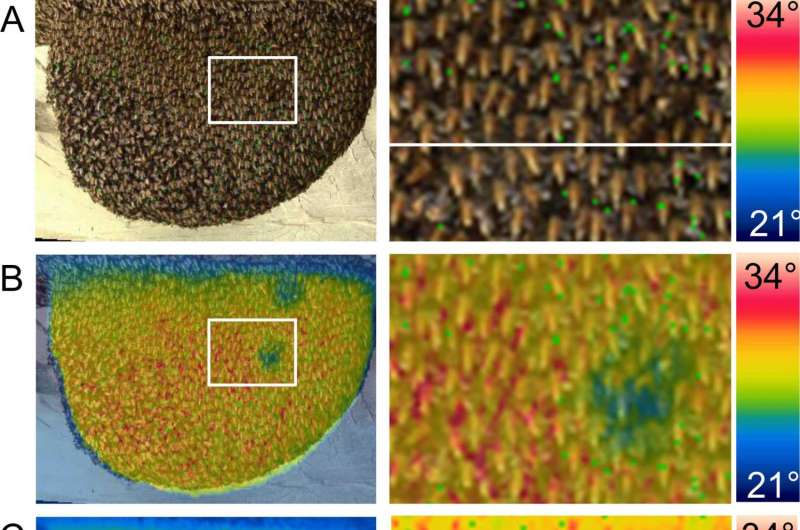Asian giant honeybees may move in synchrony to ventilate nests

Asian giant honeybees may use synchronized movements to ventilate and cool their nests, according to a study published August 3, 2016 in the open-access journal PLOS ONE by Gerald Kastberger from the University of Graz, Austria, and colleagues.
The Asian giant honeybee, Apis dorsata, builds its large single-comb nests out in the open, making them potentially vulnerable to extremes of temperature that may threaten survival. Colonies are known to create an insulating 'bee curtain' of five to seven layers of bees covering the single central comb. Researchers had also previously observed 'cool nest regions,' small areas on the nest surface that are cooler than neighboring areas, appearing briefly in the bee curtain. To investigate colony cooling mechanisms, the authors monitored the changes in surface temperature and slow horizontal movements of the bee curtain throughout the day using an infrared camera and vibrometer in several bee nests in Nepal.
The researchers observed that certain bees in the curtain appeared to act as "fanners" during the hottest part of the day, seemingly aligning their bodies to funnel air towards the cool nest regions. They suggest that curtain bees may also move in synchrony to ventilate the nest with a mechanism analogous to mammalian inhalation.
The researchers hypothesize that the inner bees stretch their limbs against the comb, expanding the inner nest area, lowering internal pressure to draw cool fresh air through the funnels from the ambiance. When the curtain bees relax the nest interior contracts by gravity, pressing the warm stale air from the center out diffusely through the meshwork of the bee curtain, completing the ventilation cycle. While the authors did not directly observe the internal mechanism, this may be a previously unknown collective respiratory movement for nest cooling in giant honeybee colonies.
More information: Kastberger G, Waddoup D, Weihmann F, Hoetzl T (2016) Evidence for Ventilation through Collective Respiratory Movements in Giant Honeybee (Apis dorsata) Nests. PLoS ONE 11(8): e0157882. DOI: 10.1371/journal.pone.0157882
Journal information: PLoS ONE
Provided by Public Library of Science



















